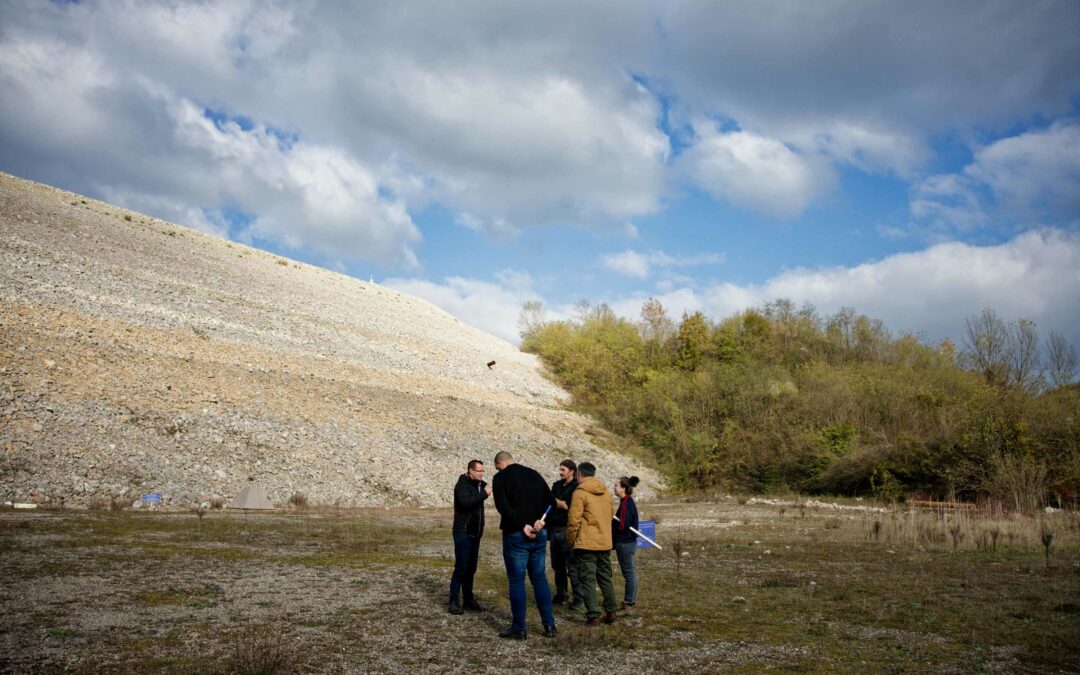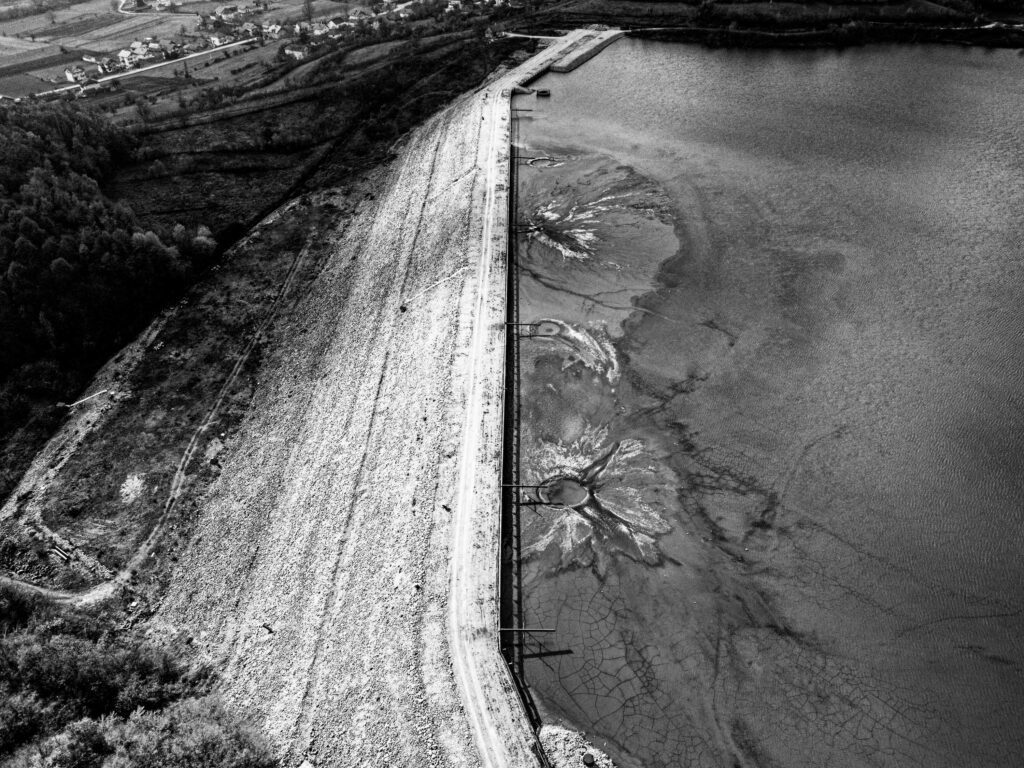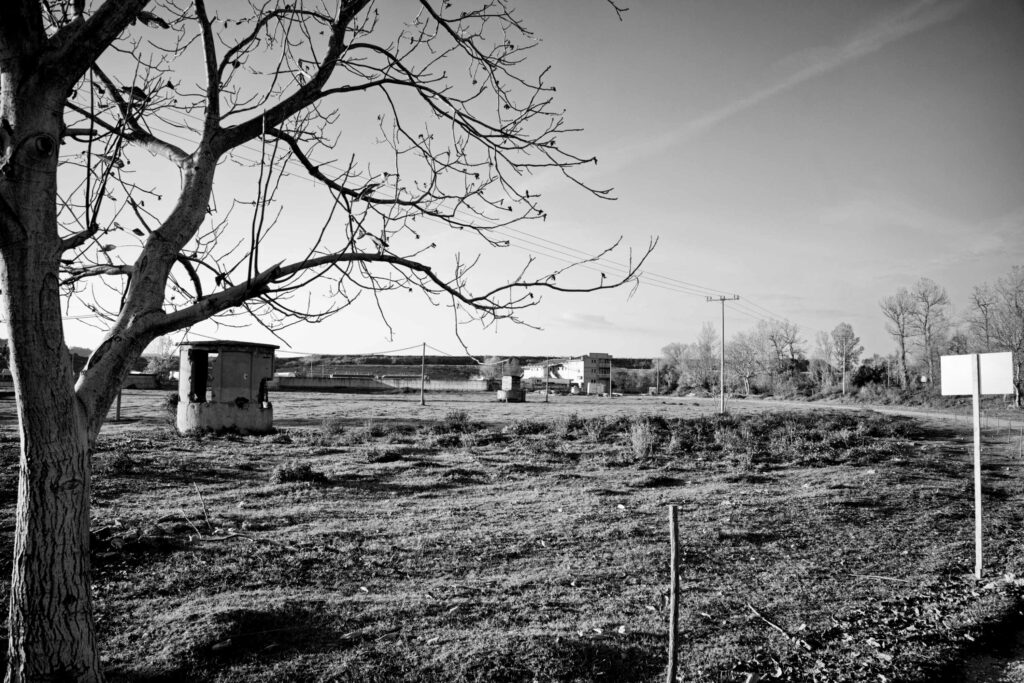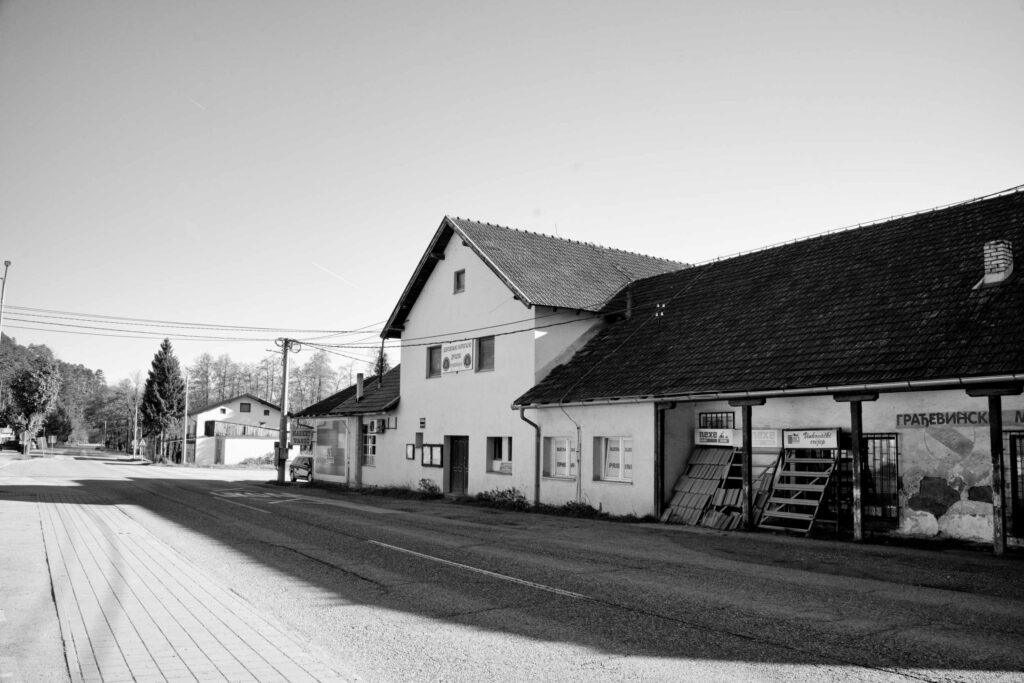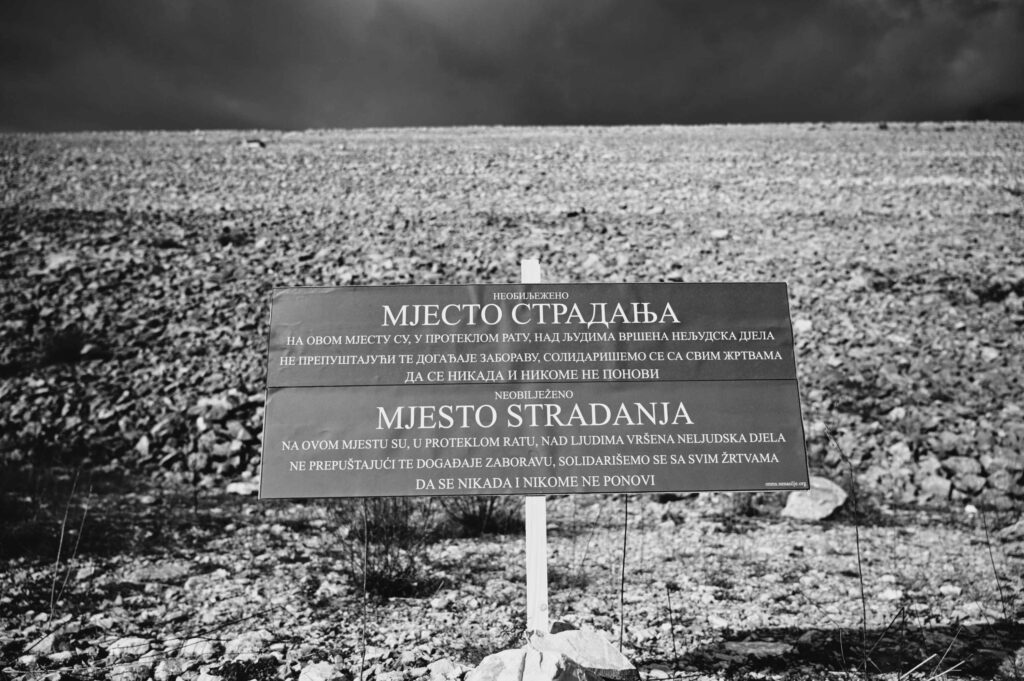As part of the twentieth action to mark unmarked sites of suffering, we visited and marked the following sites: the Desanka Maksimović Primary School in Petkovci near Zvornik, the Red Silt Dam in Petkovci near Zvornik, the Abattoir in Modrac near Lukavac, the Sloga Shoe Factory in Prnjavor, the Tannery in Vijaka near Prnjavor, the former Territorial Defence building in Teslić, the Warehouse in Pribinić near Teslić, and the hamlet of Bebe on Mount Borje near Teslić.
In cooperation with activists from the Youth Initiative for Human Rights from Croatia, we expanded the action outside the borders of BiH. Their members marked two unmarked sites of suffering: Ribnjak in Marino selo in the Požega Slavnia County, and previously Pavilion 22 at the Zagreb Fair.
Ten years of marking unmarked sites of suffering
The Initiative to Mark Unmarked Sites of Suffering started its activities in 2015 with the aim of raising awareness about sites of suffering, war crimes, imprisonment, killings and other human rights violations that had been enveloped in silence or were being denied in their local communities. This was most often the case because the victims of the crime had been members of a minority community and drawing attention to unmarked sites of suffering of minority communities runs against one of three Bosnian-Herzezgovinian para-truths about the 1990s war. This is precisely why we thought it important to point out and raise awareness about unmarked sites of suffering. To date, we have marked over 150 unmarked sites of suffering and have visited almost every city and municipality in Bosnia and Herzegovina.
One or our most significant achievements over almost ten years of this work is cooperation with people from all parts of BiH. Our actions were joined by war veterans from all the once warring armies, representatives of associations of prison camp survivors, civilian war victims and their families, foreign and local reporters, and, most importantly, young people interested in a just relationship with the past and constructive memorialisation. This cooperation is very important to us because it shows that steps forward can be made on difficult topics of dealing with the past and memorialisation, and that there is a willingness and a need among ordinary people, victims, those who felt the war on their own skin, to do something about the legacy of war that we have in common.
A voice and warning
For the twentieth action, which started in the Zvornik area, we were joined by Nedžad Avdić, a witness of genocide. In July 1995, when he was seventeen years old, Nedžad survived a mass execution on the plateau in front of the Red Silt Dam in Pektovci near Zvornik where he was among those captured after the fall of Srebrenica, which would later be characterised in numerous court judgements as genocide, and where units of the Army of Republika Srpska executed at least 814 people. Only Nedžad and one other man survived the execution and spent four days and nights wandering until they reached territory under Army of BiH control. Nedžad’s incredible story leaves you shocked and speechless, but the way he talks about his experience, his sense of calm and desire to live tell us how life must go on, and how we must do everything in our power to ensure that genocide and other wartime atrocities never happen to anyone again.
When we were marking the plateau in front of the dam in Pektovci and the Desanka Maksimović Primary School in Petkovci where he had been detained prior to the execution, Nedžad relayed how his mission was to counter the mass denial of genocide in the name of the victims who cannot speak and to be the voice to warn future generations so that this evil never happens again.
After visiting locations in Zvornik, the twentieth action to mark unmarked sites of suffering continued with the marking of the Abattoir facility in Puračić near Lukavac. The Abattoir was used in 1992 as a detention site for Serbs from the Lukavac area. The prisoners were subjected to inhuman and degrading treatment and interrogations and abuse.
Crossing invisible borders
When marking sites of suffering in the Prnjavor area, we were joined by our longstanding associates, members of the Derventa Prisoners of War Association, and together we marked the Tannery in Vijaka near Prnjavor and the Sloga Shoe Factory in Prnjavor. Both these facilities served as sites of detention in 1992 for Bosniaks and Croats from Prnjavor and Derventa and were run by units of the Army of Republika Srpska and the Republika Srpska Police. Prisoners were subjected to inhumane conditions, degrading treatment, interrogations and abuse.
Although the Bosniaks and Croats from the Prnjavor area suffered the most during the past war, representatives of the Derventa Prisoners of War Association, which brings together mostly Serbs who had been victimised by military formations made up mostly of Croats and Bosniaks, joined our action and together we visited sites of suffering in Prnjavor and in so doing demonstrated that there is a way to bridge invisible borders to compassion and memory between once warring sides in BiH. Such steps are crucial for peacebuilding in BiH because they make possible common and universal memory of experienced suffering and contribute to trust building, as opposed to exclusive memory within national communities that only deepens divisions and drives communities further from each other.
Sites of suffering in the Teslić area
We concluded the twentieth action to mark sites of suffering in the Teslić area. The former Territorial Defence building in Teslić served as a detention site for Bosniaks and Croats from Teslić and was run by forces of the Army of Republika Srpska and the reserve police unit known as “Miće”. The prisoners were subjected to interrogations, abuse and beatings, and 40 prisoners from this facility were killed during August 1992. The warehouse facility in Pribinić near Teslić was used as a detention site for more than 200 Bosniaks and Croats from Teslić. The prisoners were abused and beaten, and several prisoners died as a result.
The Bebe hamlet on the way from Teslić to Mount Borje is an unmarked site of suffering where 28 Bosniaks and Croats who had previously been detained in the Teslić area were executed. The prisoners were brought to a previously prepared mass grave in the hamlet of Bebe and killed there.
Marking sites in Croatia
The twentieth action being carried out in BiH was also joined by activists from the Youth Initiative for Human Rights from Croatia who marked an unmarked site of suffering at Ribnjak in Marino selo in the Požega-Slavonia County. In 1991, the Ribnjak site was a place of detention for Serbs, of whom at least 18 died as a result of abuse, torture and beatings. The facility was run by military police units of the 76th Independent Battalion of the Croatian National Guard.
We had previously cooperated with activists of the Initiative when in 2018 they marked Pavilion 22 at the Zagreb Fair as an unmarked site of suffering, a place where Serbs from the Zagreb area had been detained and killed during 1991.
Beacons of Peace
The past 20 actions to mark unmarked sites of suffering would not have been possible without individuals who were prepared to speak about their pain, their fears, the nights they survived imprisoned in places that remain inaccessible as sites of memory where people could pay their respects. Much of this would not have been possible without Nadežda who mustered the courage to join us in 2018 for an action and visited Bravnice near Jajce for the first time since 13 September 1995 when she was wounded after the refugee bus she was on was attacked. It would not have been possible without the late Stano, our great friend, associate and pillar of support, who as a prison camp survivor and veteran of HVO visited five or six locations in Mostar and marked the sites where he had been detained, as well as sites where the military formation he belonged to had detained people, pointing out the importance of appropriate memorialisation for the sake of future generations. It would have been much more difficult if it weren’t for Edin who came with us on visits around Prijedor and in Central Bosnia, and whose life and example are a beacon showing how a single person can be both a veteran and a prison camp survivor and a peace activist, and how they can make so many positive changes and steps towards peace in their community.
We were also helped by Drago, Ekrem, Spasoje, Strikan, Đoko, Slaviša, Perica, the late Anđelko, Nedžad, Prof. Omerika and many others we met while marking 150 sites, sometimes difficult to access, such as pits, ruins, schools, cultural centres, former factories and halls, various warehouses, and doing the most valuable thing each of us individually can do, which is a human step towards a better and more just society. A human step in paying respects, for the kind of memorialisation we all need, and especially the future generations. These individuals are the sparks of change and the personal connection that is crucial to finally start healing and overcoming the painful points of our common past.
Over the past ten years, together with these supportive individuals, members of the team that marks unmarked sites of suffering, Amer, Tamara, Dalmir, Čedo, Ajdin, embarked on a journey of growth, facing painful places that are enveloped in silence or denial in their communities. Together, they tried to change in a just way the memory and memorialisation of our painful and complex past, of victims, those that are gone, but whose stories are key for us to start healing our society together and reconciling in a way that is just. With Amer, we visited Zavidovići and the 13th Kilometre, with Tamara we visited sites in Zvornik and Sarajevo, with Čedo we visited his hometown of Bratunac and also Hadžići, Ajdin and Dalmir twice visited Livno and marked unmarked sites of suffering.
This is the element that is needed to take these very necessary steps in peacebuilding; by remembering the evil that happened, to make sure it never happens again. These small steps made by ordinary people, our associates, individuals and team members, these are key drivers of change from the grassroots, from the foundations that are formed by people who serve as beacons of peace.
Video from the action:

